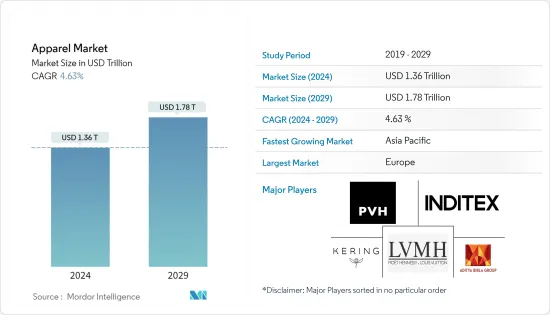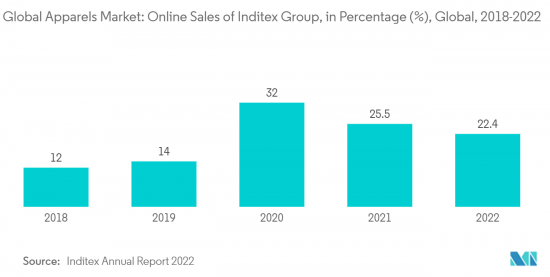 |
市場調査レポート
商品コード
1406039
アパレル:市場シェア分析、産業動向と統計、2024年~2029年の成長予測Apparel - Market Share Analysis, Industry Trends & Statistics, Growth Forecasts 2024 - 2029 |
||||||
● お客様のご希望に応じて、既存データの加工や未掲載情報(例:国別セグメント)の追加などの対応が可能です。 詳細はお問い合わせください。
| アパレル:市場シェア分析、産業動向と統計、2024年~2029年の成長予測 |
|
出版日: 2024年01月04日
発行: Mordor Intelligence
ページ情報: 英文 120 Pages
納期: 2~3営業日
|
- 全表示
- 概要
- 目次
アパレル市場規模は2024年に1兆3,600億米ドルと推定され、2029年には1兆7,800億米ドルに達し、予測期間中(2024年~2029年)のCAGRは4.63%で成長すると予測されます。

主なハイライト
- アパレル市場では、オンライン・ショッピングの増加が成長を後押しすると予想されます。メーカー各社は、以前よりもはるかに大規模なプラットフォームで製品を販売できるようになったため、顧客ベースを地理的に拡大できます。これは、アパレル業界の成長を後押しすると思われます。
- eコマース・ポータルは、以前は1つの地域に限定されていた生産者により多くの露出を提供することで、数カ国の伝統的な衣料品の売上を増加させました。例えば、アマゾンは2022年に、以前は北米に限定されていた高級品の販売を欧州でも開始しました。欧州への高級ファッションの拡大は、英国、フランス、イタリア、スペイン、ドイツのアマゾンで購入できる高級ブランドのコレクションで構成されています。
- 一人当たり所得の上昇とブランド品への嗜好の変化は、高級衣料品の需要を促進すると予測されています。さらに、女性用アパレル分野は、労働者階級の女性の増加に強く牽引され、急成長傾向を示しています。成熟市場であるにもかかわらず、ファッション動向の変化とブランド間の小売状況の進化が、アパレル市場の活況にとって重要な要因となっています。そのため競合は激しく、アパレル各社はより強力な前面を打ち出すために提携を結ぶことが多いです。広告戦略を成功させ、専門的なニーズに集中することで、アパレル企業は収益拡大を実現しています。
アパレル市場の動向
アパレルビジネスを牽引するeコマース
- 革新的なデザイン、ファストファッションの動向、クリエイティブなマーケティング戦略は、アパレル業界の成長にとって重要な要素です。消費者がインターネットやeコマースに接する機会が増えたことで、ファッション意識が向上し、ハイエンドブランドや限定品が入手しやすくなった。インフルエンサーを活用することは、ファッション企業が商品を販売し、売上を伸ばす方法に影響を与えています。例えば、スティーブ・マデン(Steve Madden)は2022年11月、南アフリカのメディア・タレント、ボナン・マテバ(Bonang Matheba)とのアフリカ初のコラボレーションを発表しました。アパレル、フットウェア、アクセサリーのブランドであるスティーブ・マデンは、このコラボレーションはアフリカでの10周年記念の一環であると述べています。
- さらに、持続可能なアプローチを持つ地元の新興企業は、世界中で顧客の関心を集めています。これらのスタートアップ企業は、フォーマル、カジュアル、トラディショナルウェアなど様々なスタイルを提供し、ユニークなデザインとコンセプトで顧客を魅了しています。さらに、消費者がパソコンやハンドヘルドデバイスからワードローブを購入することに徐々に慣れてきたため、オンラインアパレル販売は近年ブームとなっています。例えば、国際貿易局米国商務省によると、2022年1月現在、カナダ人の55%がモバイル端末でオンライン小売購入を行っており、この傾向はますます強まっています。ミレニアル世代(18~34歳)の顧客がこの動向をリードしており、彼らの47%が少なくとも週に1回はオンラインで買い物をしています。こうした要因が、アパレル市場におけるeコマース売上を後押ししています。アパレルのオンライン販売の成長は、主にウェブのみの新興企業によるものです。

アジア太平洋地域が急成長市場
- アジア太平洋地域は、繊維産業における政府の様々な取り組みにより、世界のアパレル市場で大きなシェアを占めると予想されています。例えば、中国の繊維・アパレル産業の管理機関であるCNTACは、第14次5カ年計画を発表し、2021年から2025年までの中国の繊維・アパレル産業の開発目標、成長戦略、優先課題を詳述しました。中国はまた、世界的に見ても主要な衣料品輸出国のひとつです。
- 例えば、中国税関総署(GACC)が発表したデータによると、中国は2021年に1,702億6,000万米ドルの衣料品とアクセサリーを輸出しました。さらに、大手企業はより幅広い消費者層を獲得するため、アジア諸国への進出を計画しています。例えば、2022年11月、アメリカの紳士服ブランドJoseph Abboudは、中国の大手高級ファッション小売グループであるShanghai Youxiangと提携し、中国での事業拡大計画を発表しました。
- さらに、インドの人口増加、可処分所得の増加、ファッション動向の進化は、同国のアパレル市場を押し上げると予想されます。また、インドは繊維製品の重要な輸出国であり、アパレル市場の成長を促進しています。さまざまな政府の取り組みが、繊維・衣料品産業の発展をさらに後押ししています。例えば、改正技術向上基金スキームや事前認可スキームといった政府のイニシアチブは、国内の繊維・アパレル製品の生産を強化・増加させることに重点を置いています。また、インド政府は、インドのアパレル市場の輸出競争力を高めるため、2024年3月までの衣料品・既製品の輸出に対する州税・中央税・課徴金の還付プロジェクト(RoSCTLscheme)の継続を承認しました。
アパレル産業の概要
世界のアパレル市場は細分化されており、様々な大手・中小企業が存在します。新興国市場の市場は未組織で、複数の製品を提供しています。世界ブランドの広大な流通網は国際市場に影響を与えるが、地域のファッション嗜好や価格に関して、地元メーカーとの激しい競争に直面しています。市場の主要企業には、PVH社、ケリングSA、LVMH、インディテックスなどがあります。これらのプレイヤーは、知名度と商品ポートフォリオを拡大するため、商品イノベーション、パートナーシップ、オンライン・オフラインマーケティングの強化、M&Aなどのビジネス戦略を実施しています。市場の急速な成長のため、製品革新は最も一般的な戦略となっています。そのため、企業は既存の製品とは一線を画すユニークな製品にするため、持続可能な素材を使用した革新的な新製品を発表しています。
その他の特典:
- エクセル形式の市場予測(ME)シート
- 3ヶ月間のアナリスト・サポート
目次
第1章 イントロダクション
- 調査の前提条件と市場定義
- 調査範囲
第2章 調査手法
第3章 エグゼクティブサマリー
第4章 市場力学
- 市場促進要因
- デジタルマーケティングと革新的デザインが市場を牽引
- アパレルのパーソナライゼーションとカスタマイズに対する需要の高まり
- 市場抑制要因
- 手頃な価格設定のローカルブランドとの競合
- ポーターのファイブフォース分析
- 新規参入業者の脅威
- 買い手・消費者の交渉力
- 供給企業の交渉力
- 代替品の脅威
- 競争企業間の敵対関係の強さ
第5章 市場セグメンテーション
- エンドユーザー
- 男性
- 女性
- 子供
- タイプ
- フォーマルウェア
- カジュアルウェア
- スポーツウェア
- ナイトウェア
- その他のタイプ
- 地域
- 北米
- 米国
- カナダ
- メキシコ
- その他の北米地域
- 欧州
- スペイン
- 英国
- ドイツ
- フランス
- イタリア
- ロシア
- その他の欧州
- アジア太平洋
- 中国
- 日本
- インド
- オーストラリア
- その他のアジア太平洋
- 南米
- ブラジル
- アルゼンチン
- その他の南米
- 中東・アフリカ
- サウジアラビア
- 南アフリカ
- その他の中東・アフリカ
- 北米
第6章 競合情勢
- 最も採用されている戦略
- 市場シェア分析
- 企業プロファイル
- PVH Corp.
- Inditex
- Kering SA
- LVMH
- Aditya Birla Group
- Hennes & Mauritz AB
- Nike Inc.
- Adidas AG
- Puma
- Shein
- H&M Hennes & Mauritz Retail Pvt. Ltd.
- Reliance Retail
第7章 市場機会と今後の動向

The Apparel Market size is estimated at USD 1.36 trillion in 2024, and is expected to reach USD 1.78 trillion by 2029, growing at a CAGR of 4.63% during the forecast period (2024-2029).
Key Highlights
- In the apparel market, growth is expected to be aided by increased online shopping. Manufacturers can now sell their products across a much larger platform than before, which means they can expand their customer base geographically. This will boost the growth of the apparel industry.
- E-commerce portals increased sales of traditional garments in a few countries by providing greater exposure to producers who were previously restricted to one geographic area. For instance, in 2022, Amazon launched its luxury offering to Europe, which was earlier restricted within the borders of North America. The expansion of the high-end fashion range to Europe consists of collections from luxury brands made available to purchase via Amazon in the United Kingdom, France, Italy, Spain, and Germany.
- The rising per capita income and the shift in preference for branded products are projected to drive the demand for luxury wear. Additionally, the women's apparel segment shows a rapid growth trend, strongly driven by the increasing number of working-class women. Despite being a mature market, the changing fashion trends and the evolving retail landscape across brands have been critical factors for the booming apparel market. Therefore, competition is steep, so apparel companies often create alliances to present a stronger front. Successful advertising strategies and concentration on specialized needs help apparel companies generate increased revenue.
Apparel Market Trends
E-Commerce Driving the Apparel Business
- Innovative designs, fast fashion trends, and creative marketing strategies are key factors for the apparel industry's growth. The increased exposure to the internet and e-commerce among consumers has improved the fashion consciousness and availability of high-end brands and limited edition products. Using influencers has impacted how fashion companies market their products and look to increase sales. For instance, in November 2022, Steve Madden announced its first-ever African collaboration with South African media personality Bonang Matheba. The apparel, footwear, and accessory brand stated that this collaboration is part of their 10-year celebration in Africa.
- Additionally, local startups with sustainable approaches are gaining customers' interest worldwide. These startups offer different styles, such as formal, casual, and traditional wear, with unique designs and concepts that attract customers. In addition, online apparel sales have seen a boom over recent years as consumers have gradually become more comfortable making wardrobe purchases from their computers and handheld devices. For instance, according to the International Trade Administration US Department of Commerce, 55% of Canadians performed online retail purchases via their mobile devices as of January 2022, and this tendency is increasing. Customers in the millennial generation (those between the ages of 18 and 34) are leading the trend, with 47% of them making at least one weekly purchase online. These factors help in boosting e-commerce sales in the apparel market. The growth in online apparel sales is mainly attributed to web-only startups.

Asia-Pacific Is the Fastest Growing Market
- The Asia-Pacific region is expected to hold a prominent share of the global apparel market due to various government initiatives in the textile industry. For instance, the CNTAC, the governing body of China's textile and apparel industry, released its 14th five-year plan, detailing the development objectives, growth strategies, and priority tasks for China's textile and apparel sector for 2021-2025. China is also one of the major exporters of garments worldwide.
- For instance, according to the data released by the General Administration of Customs, China (GACC), China exported USD 170.26 billion of garments and accessories in 2021. Moreover, major companies are planning their expansion to Asian countries to gain a broader consumer base. For instance, in November 2022, American menswear brand Joseph Abboud announced its expansion plans in China by partnering with Shanghai Youxiang, China's leading luxury fashion retail group.
- Furthermore, India's rising population, growth in disposable income, and evolving fashion trends are anticipated to boost the country's apparel market. India is also a significant exporter of textiles, promoting the apparel market growth. Various government initiatives are further fueling the development of the textile and garment industry. For instance, government initiatives such as the Amended Technology Upgradation Fund Scheme and the Advance Authorization Scheme are focused on strengthening and increasing the production of textile and apparel products in the country. The Government of India has also approved the continuation of the project for rebate of state and central taxes and levies on the export of garments and made-ups (RoSCTLscheme) up to March 2024 to boost the export competitiveness of the Indian apparel market.
Apparel Industry Overview
The global apparel market is fragmented in nature, with the presence of various primary and smaller players. The market in the developing regions is unorganized, offering multiple products. The vast distribution network of global brands influences the international markets but faces steep competition from local manufacturers regarding regional fashion preferences and prices. Some of the major players in the market are PVH Corp., Kering SA, LVMH, and Inditex. These players have been undertaking business strategies, including product innovations, partnerships, strengthening online and offline marketing, and mergers and acquisitions to expand their visibility and portfolio of offerings. Owing to the rapidly developing nature of the market, product innovations have become the most commonly preferred strategy among all. Therefore, companies have been introducing new and innovative products with sustainable fabrics to make their products unique from existing ones.
Additional Benefits:
- The market estimate (ME) sheet in Excel format
- 3 months of analyst support
TABLE OF CONTENTS
1 INTRODUCTION
- 1.1 Study Assumptions and Market Definition
- 1.2 Scope of the Study
2 RESEARCH METHODOLOGY
3 EXECUTIVE SUMMARY
4 MARKET DYNAMICS
- 4.1 Market Drivers
- 4.1.1 Digital Marketing and Innovative Designs Driving the Market
- 4.1.2 Growing Demand for Apparel Personalization and Customization
- 4.2 Market Restraints
- 4.2.1 Competition from Local Brands with Affordable Pricing
- 4.3 Porter's Five Forces Analysis
- 4.3.1 Threat of New Entrants
- 4.3.2 Bargaining Power of Buyers/Consumers
- 4.3.3 Bargaining Power of Suppliers
- 4.3.4 Threat of Substitute Products
- 4.3.5 Intensity of Competitive Rivalry
5 MARKET SEGMENTATION
- 5.1 End User
- 5.1.1 Men
- 5.1.2 Women
- 5.1.3 Children
- 5.2 Type
- 5.2.1 Formal Wear
- 5.2.2 Casual Wear
- 5.2.3 Sportswear
- 5.2.4 Nightwear
- 5.2.5 Other Types
- 5.3 Geography
- 5.3.1 North America
- 5.3.1.1 United States
- 5.3.1.2 Canada
- 5.3.1.3 Mexico
- 5.3.1.4 Rest of North America
- 5.3.2 Europe
- 5.3.2.1 Spain
- 5.3.2.2 United Kingdom
- 5.3.2.3 Germany
- 5.3.2.4 France
- 5.3.2.5 Italy
- 5.3.2.6 Russia
- 5.3.2.7 Rest of Europe
- 5.3.3 Asia-Pacific
- 5.3.3.1 China
- 5.3.3.2 Japan
- 5.3.3.3 India
- 5.3.3.4 Australia
- 5.3.3.5 Rest of Asia-Pacific
- 5.3.4 South America
- 5.3.4.1 Brazil
- 5.3.4.2 Argentina
- 5.3.4.3 Rest of South America
- 5.3.5 Middle East & Africa
- 5.3.5.1 Saudi Arabia
- 5.3.5.2 South Africa
- 5.3.5.3 Rest of Middle East & Africa
- 5.3.1 North America
6 COMPETITIVE LANDSCAPE
- 6.1 Most Adopted Strategies
- 6.2 Market Share Analysis
- 6.3 Company Profiles
- 6.3.1 PVH Corp.
- 6.3.2 Inditex
- 6.3.3 Kering SA
- 6.3.4 LVMH
- 6.3.5 Aditya Birla Group
- 6.3.6 Hennes & Mauritz AB
- 6.3.7 Nike Inc.
- 6.3.8 Adidas AG
- 6.3.9 Puma
- 6.3.10 Shein
- 6.3.11 H&M Hennes & Mauritz Retail Pvt. Ltd.
- 6.3.12 Reliance Retail
